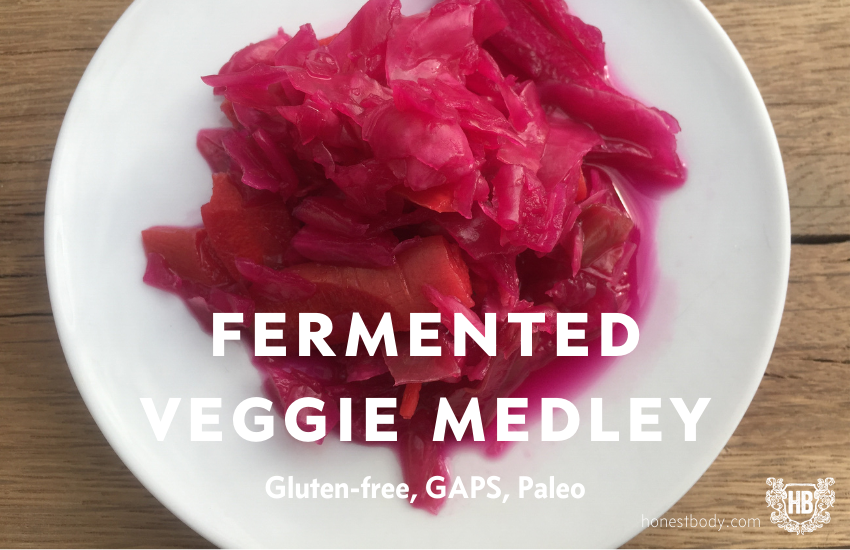The consumption of probiotic foods is essential to the GAPS protocol and this fermented veggie medley is an easy way to meet this requirement.
Since dairy is an issue for many (at least at the beginning), fermented vegetables are a must. This recipe is inspired by the fermented veggie medley recipe on page 197 of Dr. Natasha Campbell-McBride’s book, Gut and Psychology Syndrome.
It’s a delicious addition to any meal and I always get compliments from guests. As Dr. Natasha says, the brine is “a wonderful beverage to drink, full of great nutrition and beneficial bacteria” and she lists it as “an excellent remedy for any tummy upset, sore gums and sore throat.” This is the go-to fermented veggie recipe in our home because of its versatility – it tastes good with almost any meal, adding a little salty zing.
Print
Fermented Vegetable Medley
- Author: Deanna Wilson
Description
A versatile fermented vegetable recipe that is beautiful and delicious with any meal. Perfect for all stages of GAPS.
Ingredients
-
- 1 large or 2 small heads of cabbage (about 2.5 lbs)
- 3 large carrots
- 1 large beet
- 5 garlic cloves
- 1 tsp. dill seed
- 2 tsp. dried dill
- 35 grams (about 2 Tbs) of Himalayan salt (any high quality salt will do, but different salts have different weights, so be aware that the measurement may be different if you use other salts)
- 1–2 quarts of filtered water (cannot be chlorinated)
- 1/4 tsp starter culture such as Caldwell’s
Supplies:
- Anaerobic fermentation jar and weights (can be found here: Pickl-it)
- Pickle pounder or french rolling pin
- Large glass or wooden bowl
Instructions
- Chop the cabbage into bite-sized strips
- Julienne the carrots and beets (but keep the skins on)
- Put the veggies in a large glass or wooden bowl with the garlic, dill seed, and dill
- Sprinkle the salt on the veggies
- Massage them by hand or mash them with a pickle pounder (the end of a french rolling pin works well too) until there is some juice on the bottom of the bowl
- Cover with a clean dishcloth and leave to sit for about 2 hours
- Pack the veggies into an anaerobic fermentation jar such as the pickl-it
- Take brine from the bottom of the bowl and mix the starter culture with the brine, pour into the jar
- Fill the rest of the jar with filtered water until veggies are submerged 1/2 to 1 inch below the surface of the brine
- Using fermentation weights, gently press the veggies down until air bubbles come out of the brine (you can use a large outer cabbage leaf for this step but I find that weights plus a large leaf work best)
- Clamp down the lid and place the air-lock
- Place in a cool, dark place (such as a cupboard) for 10 days to ferment
- Transfer to the refrigerator with airlock still on for additional curing/storage
Notes
There are many ways to ferment vegetables, this recipe uses anaerobic jars to ensure that fermentation takes place in the absence of oxygen. This ensures that lactic-acid bacteria thrive rather than undesired microbes.

